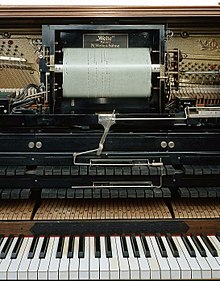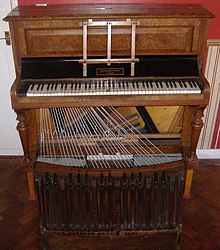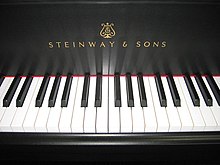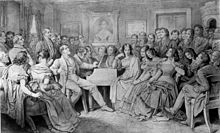Piano
This article includes a list of references, related reading, or external links, but its sources remain unclear because it lacks inline citations. (January 2008) |

The piano is a musical instrument played by means of a keyboard that produces sound by striking steel strings with felt covered hammers. The hammers immediately rebound, allowing the strings to continue vibrating at their resonant frequency.[1] These vibrations are transmitted through a bridge to a soundboard that couples the acoustic energy to the air so that it can be heard as sound.
The piano is widely used in Western music for solo performance, ensemble use, chamber music, and accompaniment. It is also very popular as an aid to composing and rehearsal. Although not portable and often expensive, the piano's versatility and ubiquity have made it one of the most familiar musical instruments. It is sometimes classified as both a percussion and a stringed instrument. According to the Hornbostel-Sachs method of music classification, it is grouped with Chordophones.
The word piano is a shortened form of the word pianoforte, which is seldom used except in formal language and derived from the original Italian name for the instrument, clavicembalo [or gravicembalo] col piano e forte (literally harpsichord with soft and loud). This refers to the instrument's responsiveness to keyboard touch, which allows the pianist to produce notes at different dynamic levels by controlling the speed with which the hammers hit the strings.
==
Modern piano

Types
Modern pianos come in two basic configurations (with subcategories): the grand piano and the upright piano.
Grand

In grand pianos, the frame and strings are horizontal, with the strings extending away from the keyboard. There are several sizes of grand piano. A rough generalization distinguishes the "concert grand" (between about 2.2 m and 3 m long) from the "parlor grand" or "boudoir grand" (about 1.7 m to 2.2 m) and the smaller "baby grand".
All else being equal, longer pianos with longer strings have better sound and lower inharmonicity of the strings. Inharmonicity is the degree to which the frequencies of overtones (known as partials, partial tones, or harmonics) depart from whole multiples of the fundamental frequency. Pianos with shorter, thicker, and stiffer strings (e.g., baby grands) have more inharmonicity. The longer strings on a concert grand can vibrate more freely than the shorter, thicker strings on a baby grand, which means that a concert grand's strings will have truer overtones. This allows the strings to be tuned closer to equal temperament in relation to the standard pitch with less "stretching" in the piano tuning (See: Piano tuning). Full-size grands are usually used for public concerts, whereas smaller grands, introduced by Sohmer & Co. in 1884, are often chosen for domestic use where space and cost are considerations.
Upright

Upright pianos, also called vertical pianos, are more compact because the frame and strings are vertical. It is considered harder to produce a sensitive piano action when the hammers move horizontally, as the vertical hammer return is dependent on springs which are prone to wear and tear. However, a well-regulated vertical piano will probably play more smoothly than a poorly regulated grand piano, and the very best upright pianos approach the level of some grand pianos of the same size in tone quality and responsiveness.
One noticeable advantage that the grand piano action has over the vertical action is that all grand pianos have a special repetition lever in the playing action that is absent in all verticals. This repetition lever, a separate one for every key, catches the hammer close to the strings as long as the keys are played repeatedly and fairly quickly. In this position, with the hammer resting on the lever, a pianist can play repeated notes, staccato, and trills with much more speed and control than is possible on a vertical piano.
Upright pianos with unusually tall frames and long strings are sometimes called "upright grand" pianos.
Some authors classify modern pianos according to their height and, to modifications of the action that are necessary to accomodate the height.
- Studio pianos are around 42 to 45 inches tall. This is the shortest cabinet that can accomodate a 'full-sized' action located above the keyboard.
- Console pianos have a compact action (shorter hammers), and are a few inches shorter than studio models.
- The top of a Spinet model barely rises above the keyboard. The action is located below, operated by vertical wires that are attached to the backs of the keys.
- Anything taller than a studio piano is called an upright.
Other types

Toy pianos began to be manufactured in the 19th century. In 1863, Henri Fourneaux invented the player piano, which "plays itself" from a piano roll without the need for a pianist. The player piano is a piano that records a performance using rolls of paper with perforations, and then replays the performance using pneumatic devices. A modern equivalent for the player piano is the Yamaha Disklavier system, which uses solenoids and midi instead of pneumatics and rolls. Silent pianos, which allow a regular piano to be used converted to a digital instrument, are a recent innovation and are becoming more popular.
Irving Berlin played a special piano called the transposing piano, which was invented in 1801 by Edward Ryley. It had a lever under the keyboard used to alter the music to any key. One of Berlin's pianos is in the Smithsonian Museum. For much of his career, Berlin only knew how to play the black keys. But with his 'trick piano' he was no longer limited to the key of F-sharp.
A relatively recent development is the prepared piano, which is used in contemporary art music. A prepared piano is a standard grand piano which has had objects placed inside it before a performance in order to alter its sound, or which has had its mechanism changed in some way. The scores for music for prepared piano often instruct the pianist to insert pieces of rubber or small pieces of metal (screws or washers) in between the strings. These added items either mute the strings or create unusual vibrating sounds.
Since the 1980s, digital pianos have been available, which use digital sampling technology to reproduce the sound of each piano note. The best digital pianos are sophisticated, with features including working pedals, weighted keys, multiple voices, and MIDI interfaces. However, with such technology, it is difficult to duplicate one particular aspect of acoustic pianos, namely that when the damper pedal (see below) is depressed, the strings not struck vibrate sympathetically when other strings are struck, as well as the unique instrument-specific mathematical non-linearity of partials on any given unison. Since this sympathetic vibration is considered central to piano tone,[citation needed] many digital pianos do not sound the same as the best acoustic pianos. Progress is being made in this area by including physical models of sympathetic vibration in the synthesis software. Some higher end digital pianos, such as the Yamaha Clavinova series, or the KAWAI MP8 series, produced in the last few years incorporate string resonance technology to overcome this limitation.
With the advent of powerful desktop computers, highly realistic sampled digital grand pianos have become available as affordable software modules. Some use multi-gigabyte piano sample sets with as many as 90 recordings, each lasting many seconds, for each of the 88 keys under different conditions, augmented by additional samples to emulate sympathetic resonance, key release, the drop of the dampers, and simulations of piano techniques like re-pedaling.
Keyboard

Almost every modern piano has 36 black keys and 52 white keys for a total of 88 keys (seven octaves plus a minor third, from A0 to C8). Many older pianos only have 85 keys (seven octaves from A0 to A7), while some manufacturers extend the range further in one or both directions.
Some Bösendorfer pianos extend the normal range downwards to F0, with one other model going as far as a bottom C0, making a full eight octave range. These extra keys are sometimes hidden under a small hinged lid that can be flipped down to cover the keys in order to avoid visual disorientation in a pianist unfamiliar with the extended keyboard. On others, the colours of the extra white keys are reversed (black instead of white).
The extra keys are added primarily for increased resonance from the associated strings; that is, they vibrate sympathetically with other strings whenever the damper pedal is depressed and thus give a fuller tone. Only a very small number of works composed for piano actually use these notes. More recently, the Stuart and Sons company has also manufactured extended-range pianos. On their instruments, the range is extended both down the bass to F0 and up the treble to F8 for a full eight octaves. The extra keys are the same as the other keys in appearance.
Small studio upright acoustical pianos with only 65 keys have been manufactured for use by roving pianists. Known as "gig" pianos and still containing a cast iron harp, these are comparatively lightweight and can be easily transported to and from engagements by only two people. As their harp is longer than that of a spinet or console piano, they have a stronger bass sound that to some pianists is well worth the trade-off in range that a reduced key-set offers.
Pedals
Standard pedals

Pianos have had pedals, or some close equivalent, since the earliest days. (In the 18th century, some pianos used levers pressed upward by the player's knee instead of pedals.) Most grand pianos have three pedals: soft pedal (una corda), sostenuto, and sustain pedal (from left to right, respectively). Most modern upright pianos have three pedals: soft pedal, practice pedal and sustain pedal, though older or cheaper models may lack the practice pedal.
The sustain pedal (or, damper pedal) is often simply called "the pedal", since it is the most frequently used. It is placed as the rightmost pedal in the group. It lifts the dampers from all keys, sustaining all played notes, and altering the overall tone.
The soft pedal or una corda pedal is placed leftmost in the row of pedals. In grand pianos, it shifts the entire action, including the keyboard, to the right, so that the hammers hit only one of the three strings for each note (hence the name una corda, or 'one string'). The effect is to soften the note as well as to change the tone. In uprights, this action is not possible, and so the pedal moves the hammers closer to the strings, allowing the hammers to hit the strings with less kinetic energy to produce a softer sound.
On grand pianos, the middle pedal is a sostenuto pedal. This pedal keeps raised any damper that was already raised at the moment the pedal is depressed. This makes it possible to sustain some notes (by depressing the sostenuto pedal before notes to be sustained are released) while the player's hands are free to play other notes. This can be useful for musical passages with pedal points and other otherwise tricky or impossible situations.
On many upright pianos, there is a middle pedal called the 'practice' or celeste pedal. This drops a piece of felt between the hammers and strings, greatly muting the sounds.
There are also non-standard variants. On vertical pianos, the middle pedal can be a bass sustain pedal: that is, when it is depressed, the dampers lift off the strings only in the bass section. This pedal would be used only when a pianist needs to sustain a single bass note or chord over many measures, while playing the melody in the treble section. On the largest Fazioli piano, there is a fourth pedal to the left of the principal three. This fourth pedal works in the same way as the soft pedal of an upright piano, moving the hammers closer to the strings.[2]
Unusual pedals

The rare transposing piano, of which Irving Berlin possessed an example, had a middle pedal that functioned as a clutch which disengages the keyboard from the mechanism, enabling the keyboard to be moved to the left or right with a lever. The entire action of the piano is thus shifted to allow the pianist to play music written in one key so that it sounds in a different key. The pedalier piano, or pedal piano, is a rare type of piano that includes a pedalboard, enabling bass register notes to be played with the feet, as is standard on the organ. There are two types of pedal piano: the pedal board may be an integral part of the instrument, using the same strings and mechanism as the manual keyboard, or, less frequently, it may consist of two independent pianos (each with its separate mechanics and strings) which are placed one above the other, a regular piano played by the hands and a bass-register piano played by the feet.
Construction
Many parts of a piano are made of materials selected for sturdiness. In quality pianos, the outer rim of the piano is made of a hardwood, normally maple or beech. According to Harold A. Conklin, the purpose of a sturdy rim is so that "the vibrational energy will stay as much as possible in the soundboard instead of dissipating uselessly in the case parts, which are inefficient radiators of sound."

The rim is normally made by laminating flexible strips of hardwood to the desired shape, a system that was developed by Theodore Steinway in 1880. The thick wooden braces at the bottom (grands) or back (uprights) of the piano are not as acoustically important as the rim, and are often made of a softwood, even in top-quality pianos, in order to save weight. The requirement of structural strength, fulfilled with stout hardwood and thick metal, makes a piano heavy; even a small upright can weigh 136 kg (300 lb), and the Steinway concert grand (Model D) weighs 480 kg (990 lb). The largest piano built, the Fazioli F308, weighs 691 kg (1520 lb).
The pinblock, which holds the tuning pins in place, is another area of the piano where toughness is important. It is made of hardwood, (often maple) and generally is laminated (built of multiple layers) for additional strength and gripping power. Piano strings (also called piano wire), which must endure years of extreme tension and hard blows, are made of high quality steel. They are manufactured to vary as little as possible in diameter, since all deviations from uniformity introduce tonal distortion. The bass strings of a piano are made of a steel core wrapped with copper wire, to increase their mass whilst retaining flexibility.
The plate, or metal frame, of a piano is usually made of cast iron. It is advantageous for the plate to be quite massive. Since the strings are attached to the plate at one end, any vibrations transmitted to the plate will result in loss of energy to the desired (efficient) channel of sound transmission, namely the bridge and the soundboard. Some manufacturers now use cast steel in their plates, for greater strength. The casting of the plate is a delicate art, since the dimensions are crucial and the iron shrinks by about one percent during cooling.
The inclusion in a piano of an extremely large piece of metal is potentially an aesthetic handicap, which piano makers overcome by polishing, painting and decorating the plate. Plates often include the manufacturer's ornamental medallion and can be strikingly attractive. In an effort to make pianos lighter, Alcoa worked with Winter and Company piano manufacturers to make pianos using an aluminum plate during the 1940s. The use of aluminum for piano plates, however, did not become widely accepted and was discontinued.
The numerous grand parts and upright parts of a piano action are generally hardwood (e.g. maple, beech. hornbeam). However, since World War II, plastics have become available. Early plastics were incorporated into some pianos in the late 1940s and 1950s, but proved disastrous because they crystallized and lost their strength after only a few decades of use. The Steinway firm once incorporated Teflon, a synthetic material developed by DuPont, for some grand action parts in place of cloth, but ultimately abandoned the experiment due to an inherent "clicking" which invariably developed over time. (Also Teflon is "humidity stable" whereas the wood adjacent to the Teflon will swell and shrink with humidity changes, causing problems.) More recently, the Kawai firm has built pianos with action parts made of more modern and effective plastics such as carbon fiber; these parts have held up better and have generally received the respect of piano technicians[citation needed].

The part of the piano where materials probably matter more than anywhere else is the soundboard. In quality pianos, this is made of solid spruce (that is, spruce boards glued together at their edges). Spruce is chosen for its high ratio of strength to weight. The best piano makers use close-grained, quarter-sawn, defect-free spruce, and make sure that it has been carefully dried over a long period of time before making it into soundboards. In cheap pianos, the soundboard is often made of plywood.
Piano keys are generally made of spruce or basswood, for lightness. Spruce is normally used in high-quality pianos. Traditionally, the black keys were made from ebony and the white keys were covered with strips of ivory, but since ivory-yielding species are now endangered and protected by treaty, plastics are now almost exclusively used. Also, ivory tends to chip more easily than plastic. Legal ivory can still be obtained in limited quantities. At one time, the Yamaha firm innovated a plastic called "Ivorine" or "Ivorite", since imitated by other makers, that mimics the look and feel of ivory.
Care and maintenance

Pianos need regular tuning to keep them up to pitch, which is usually the internationally recognized standard concert pitch of A4 = 440 Hz. The hammers of pianos are voiced to compensate for gradual hardening, and other parts also need periodic regulation. Aged and worn pianos can be rebuilt or reconditioned. Often, by replacing a great number of their parts, they can be made to perform as well as new pianos. Older pianos are often more settled and produce a warmer tone.[citation needed]
Piano moving should be done by trained piano movers using adequate manpower and the correct equipment for any particular piano's size and weight.[citation needed] Pianos are heavy yet delicate instruments. Over the years, professional piano movers have developed special techniques for transporting both grands and uprights which prevent damage to the case and to the piano's mechanics.
Role

The piano is a crucial instrument in Western classical music, jazz, film, television, and most other complex western musical genres. Since a large number of composers are proficient pianists – and because the piano keyboard offers an easy means of complex melodic and harmonic interplay – the piano is often used as a tool for composition.
Pianos were, and still are, popular instruments for private household ownership. Hence, pianos have gained a place in the popular consciousness, and are sometimes referred to by nicknames including: "the ivories", "the joanna", "the eighty-eight", and "the black(s) and white(s)", "the little joe(s)". Playing the piano is sometimes referred to as "tickling the ivories".
See also
|
|
|
Notes
- ^ "Hammer Time" by John Kiehl, Wolfram Demonstrations Project.
- ^ "Fourth pedal". Fazioli. Retrieved 2008-04-21.
References
- The authoritative New Grove Dictionary of Music and Musicians (available online by subscription), contains a wealth of information. Main article: "Pianoforte".
- The Encyclopædia Britannica (available online by subscription) also includes much information on the piano. In the 1988 edition, the primary article can be found in "Musical Instruments".
- The Piano Book by Larry Fine (4th ed. Jamaica Plain, Massachusetts: Brookside Press, 2001; ISBN 1-929145-01-2) gives the basics of how pianos work, and a thorough evaluative survey of current pianos and their manufacturers. It also includes advice on buying and owning pianos.
- Giraffes, black dragons, and other pianos: a technological history from Cristofori to the modern concert grand by Edwin M. Good (1982, second ed., 2001, Stanford, Calif.: Stanford University Press) is a standard reference on the history of the piano.
- The Early Pianoforte by Stewart Pollens (1995, Cambridge: Cambridge University Press) is an authoritative work covering the ancestry of the piano, its invention by Cristofori, and the early stages of its subsequent evolution.
Further reading
- Banowetz, Joseph (1985). The pianist's guide to pedaling. Bloomington: Indiana University Press. ISBN 0-253-34494-8.
{{cite book}}: Unknown parameter|coauthors=ignored (|author=suggested) (help) - Parakilas, James (1999). Piano roles : three hundred years of life with the piano. New Haven, Connecticut: Yale University Press. ISBN 0-300-08055-7.
- Reblitz, Arthur A. (1993). Piano Servicing, Tuning and Rebuilding: For the Professional, the Student, and the Hobbyist. Vestal, NY: Vestal Press. ISBN 1-879511-03-7.
- Carhart, Thad (2002) [2001]. The Piano Shop on the Left Bank. New York: Random House. ISBN 0-375-75862-3.
- Loesser, Arthur (1991) [1954]. Men, Women, and Pianos: A Social History. New York: Dover Publications.
- Template:Nl icon Lelie, Christo (1995). Van Piano tot Forte (The History of the Early Piano). Kampen: Kok-Lyra.
- Fine, Larry (2001). The Piano Book: Buying and Owning a New or Used Piano (4th edition). Jamaica Plain, MA: Brookside Press. ISBN 1-929145-01-2.
{{cite book}}: Unknown parameter|coauthors=ignored (|author=suggested) (help)
External links
- Information
- Yamaha Musician - Yamaha piano reviews and enthusiast site
- Grand Piano information and images
- The Piano Page Lots of information from the Piano Technicians Guild
- WikiRecording's Guide to Recording Pianos
- History
- History of the Piano Forte, Association of Blind Piano Tuners, UK
- The Frederick Historical Piano Collection
- Piano Technique
- Sheet music for Piano
- All Piano Scores Free printable classical sheet music for piano + audio
